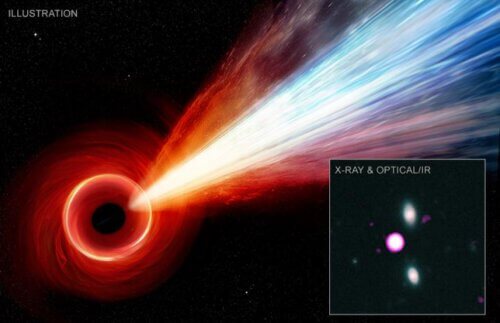The jet, whose length is greater than the length of the Milky Way galaxy, was ejected from a galaxy about a billion years after the Big Bang. The discovery may explain how the supermassive black holes found today at the centers of all galaxies were formed

From: Harvard-Smithsonian Center for Astrophysics. Translation: Avi Blizovsky
Astronomers have discovered evidence of an extremely long jet of particles coming from a supermassive black hole in the early universe, using NASA's Chandra X-ray Observatory.
If the discovery is confirmed, it would be the most distant supermassive black hole with a jet detected in X-rays. The jet comes from a galaxy about 12.7 billion light-years from Earth, and may help explain how the largest black holes formed very early in the universe's history.
The source of the jet is a quasar - a rapidly growing supermassive black hole - named PSO J352.4034-15.3373 (PJ352-15 for short), which sits at the center of a young galaxy. It is one of the two most powerful quasars ever detected using waves and we see them essentially as they were in the first billion years after the Big Bang. The black hole is a billion times more massive than the Sun.
How did supermassive black holes manage to grow so fast?
How did massive black holes manage to grow so fast and reach such enormous mass in this early period of the universe? This is one of the key questions in astronomy today.
Despite their powerful gravity and fearsome reputation, black holes don't necessarily attract everything that comes close to them. Matter surrounding the black hole's disk has to lose speed and energy before it can fall further inward to cross the so-called event horizon, the point of no return. Magnetic fields can cause a braking effect on the disc because they activate a jet, the main way that allows material in the disc to lose energy and therefore increase the growth rate of black holes.
According to Thomas Connor of NASA's Jet Propulsion Laboratory (JPL) in Pasadena. , California, who led the study. "Around supermassive black holes, we think that jets can pick up enough energy that matter can fall in and the black hole can grow."
The length of the jet is 160 thousand light years, for comparison the diameter of the Milky Way is 100 thousand light years
Astronomers were required to observe PJ352-15 for a total of three days using Chandra's sharp vision to detect evidence of the X-ray. X-ray emission was detected about 160,000 light-years away from the quasar in the same direction where much shorter jets had previously been observed in radio observations by the Very Large Base Array. By comparison, the entire Milky Way spans about 100,000 light years.
PJ352-15 breaks several different astronomical records. First, the longest previously observed jet from the first billion years after the Big Bang was only about 5,000 light-years long, which is consistent with the radio observations of PJ352-15. Second, PJ352-15 is about 300 million light-years farther than the most distant X-ray ever recorded before it.
"The length of this jet is significant because it means that the supermassive black hole driving it has been growing for quite some time," said co-author Eduardo Benados of the Max Planck Institute for Astronomy (MPIA) in Heidelberg, Germany. "This result highlights how X-ray studies of distant quasars provide a critical way to study the growth of the most distant supermassive black holes."
The light detected from this jet was emitted when the universe was only 0.98 billion years old, less than a tenth of its current age. At that time, the intensity of the cosmic background radiation left over from the Big Bang was much greater than it is today.
As the electrons in the jet fly out of the black hole at close to the speed of light, they collide with the photons that make up the cosmic background radiation, boosting the energy of the photons into the X-ray range, the radiation detected by Chandra. In this scenario, the X-rays are significantly increased in brightness compared to radio waves. This is consistent with the observation that the large X-ray jet has no associated radio emission.
"Our result shows that X-ray observations can be one of the best ways to study quasars with jets in the early universe," said co-author Daniel Stern, also of JPL. "Or to put it another way, X-ray observations of the future may be the key to unlocking the secrets of our cosmic past."
For an announcement on the Chandra Space Telescope website
More of the topic in Hayadan:

One response
All the explanations about "black holes" seem like a game for children fascinated by 'Star Wars'. Pure imaginations, not exact science! How does a black hole emit something, if we are told that it swallows 'everything' into it?…. Attach an illustration to the article - a drawing! And the x-ray image does not show what the illustration pretends to show.... It's just like "Scientific Yedioth Ahronoth"......